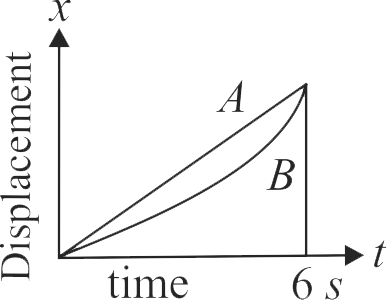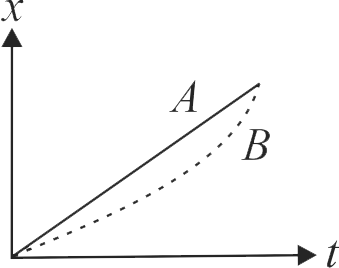362225
In the diagram shown, the displacement \({(x)}\) of particles is given as a function of time. Particle \({A}\) is moving under a constant velocity of \({9 {~m} / {s}}\). Particle \({B}\) is moving under variable acceleration. From time \({t=0 s}\) to \({t=6 s}\), the average velocity of the particle \({B}\) will be equal to
362225
In the diagram shown, the displacement \({(x)}\) of particles is given as a function of time. Particle \({A}\) is moving under a constant velocity of \({9 {~m} / {s}}\). Particle \({B}\) is moving under variable acceleration. From time \({t=0 s}\) to \({t=6 s}\), the average velocity of the particle \({B}\) will be equal to
362225
In the diagram shown, the displacement \({(x)}\) of particles is given as a function of time. Particle \({A}\) is moving under a constant velocity of \({9 {~m} / {s}}\). Particle \({B}\) is moving under variable acceleration. From time \({t=0 s}\) to \({t=6 s}\), the average velocity of the particle \({B}\) will be equal to
362225
In the diagram shown, the displacement \({(x)}\) of particles is given as a function of time. Particle \({A}\) is moving under a constant velocity of \({9 {~m} / {s}}\). Particle \({B}\) is moving under variable acceleration. From time \({t=0 s}\) to \({t=6 s}\), the average velocity of the particle \({B}\) will be equal to
362225
In the diagram shown, the displacement \({(x)}\) of particles is given as a function of time. Particle \({A}\) is moving under a constant velocity of \({9 {~m} / {s}}\). Particle \({B}\) is moving under variable acceleration. From time \({t=0 s}\) to \({t=6 s}\), the average velocity of the particle \({B}\) will be equal to

